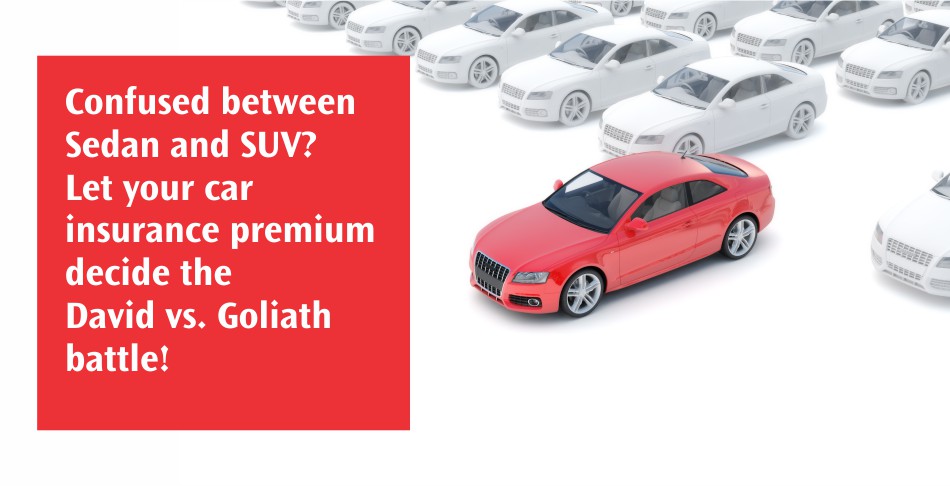Confused between Sedan & SUV? Let your car insurance premium decide the David vs. Goliath battle!
Confused between Sedan & SUV? Let your car insurance premium decide the David vs. Goliath battle!
Published on April 17, 2021. EST READ TIME: 4 minutes

Buying a car is one of the most crucial decisions that Indians make. And, with the Hindu New Year just passed, there is no better time for many to invest in a new ride. However, since car insurance is a large part of your car owning experience, we would recommend considering your car insurance premium before you select a model. Has our suggestion left you wondering? Allow us a moment to explain.
The Indian automobile sector offers its consumers varying models, starting from hatchbacks to luxury sedans, in varying designs, accessories, cubic capacity etc. Depending upon the segment your car falls in or its engine capacity or features, the cost of ownership (which includes car insurance premium) varies. Thus, while making a choice, keep the following factors in mind: they would alter your car insurance premium.
1. Car type: There are many different car types available, including hatchbacks, sedans, compact sedans, microcars, multi-purpose vehicles, sports utility vehicles (SUVs), compact SUVs, crossover SUVs and many more. The Society of Indian Automobile manufacturers has classified cars into various segments as A1, A2, A3, A4, A5, A6, B1, B2, and SUV. The general rule is that insuring a more expensive car will cost more.
2. Insured Declared Value (IDV): Your car insurance depends on the Insured Declared Value (IDV), reflecting the car's current market value. The IDV is agreed upon by the car owner and the insurer because it is also the amount of money you will receive if the car gets damaged. However, the higher the IDV, the higher the premium amount you pay. New cars, sports and luxury cars are exorbitantly priced, and their insurance premiums are higher than those of budget vehicles.
3. Fuel type: Petrol cars are considered safer than diesel, CNG, and LPG cars, and the premium is lower for petrol cars because the cost of the petrol variant is generally lower than the cost of diesel and CNG variants. Even if you save money on fuel by installing a CNG or LPG kit in your car, your insurance premium will rise.
4. Engine size: The size of the vehicle's engine is the cubic capacity (cc). According to the insurer, a larger engine size would allow for greater speed, increasing the possibility of a crash. In fact, a car's cubic capacity determines the premium of the basic third-party insurance.
5. Car specifications: A costly accessory will also raise your premium amount. Consider two cars, one the standard and the other with the latest music system or advanced braking system. Don’t you think the second will attract a thief more? This increases the risk for the insurer, who then charges you a higher premium to compensate.
6. Residential area: Even the geographical zone plays a role. If your neighbourhood is vulnerable to regular vandalism, theft, and accidents, insurers will charge you higher premiums. Tier-1 cities and metros are prone to such activities, and purchasing vehicles in such areas requires owners to pay higher premiums.
7. Discounts: Not all features increase the premium; in fact, some lower it. Say hello to the No Claim Bonus (NCB). If you have not made any claim during the previous policy period, insurers will give you a discount on your premium during car insurance renewal. Likewise, installing safety features such as airbags and anti-theft mechanisms can help you get a discount on the premium as they reduce the insurer’s risk. Choosing a voluntary deductible can also lower insurance premiums because the policyholder contributes a predetermined amount to the total claim amount. Consequently, the insurer pays less when settling a claim and, therefore, charges a lower premium.
8. Driver’s age and claim history: A young or inexperienced driver will have to pay a higher premium than an experienced driver who is less likely to drive recklessly. Also, if you have made previous claims, it sends the message that you are likely to damage the car again. In such cases, insurers may raise the premium.
Conclusion
Whether you are buying a new car or it is time for car insurance renewal, keep your budget in mind at all times. The goal should be to strike a balance between the features you need in your car and how much you can comfortably afford to pay in insurance premiums. Buying car insurance online is always the smart move as it allows you to compare various car insurance policies and make an informed decision.
Disclaimer: The above information is for illustrative purposes only. For more details, please refer to policy wordings and prospectus before concluding the sales.
This blog has been written by:
S. Gopalakrishnan | Motor Insurance Expert | 40+ years of experience in insurance industry
A veteran in insurance industry, S. Gopalakrishnan is a name to reckon with in the field of reinsurance; he has headed the Reinsurance department and has rich experience in other fields of motor insurance. He loves to share his opinion on the latest topics in the insurance industry and how he can help people in safeguarding their assets using insurance products.
Few Other Articles:










 Health Insurance
Health Insurance  Travel Insurance
Travel Insurance  Car Insurance
Car Insurance  Cyber Insurance
Cyber Insurance  Critical Illness Insurance
Critical Illness Insurance
 Pet Insurance
Pet Insurance
 Bike/Two Wheeler Insurance
Bike/Two Wheeler Insurance  Home Insurance
Home Insurance  Third Party Vehicle Ins.
Third Party Vehicle Ins.  Tractor Insurance
Tractor Insurance  Goods Carrying Vehicle Ins.
Goods Carrying Vehicle Ins.  Passenger Carrying Vehicle Ins.
Passenger Carrying Vehicle Ins.  Compulsory Personal Accident Insurance
Compulsory Personal Accident Insurance  Travel Insurance
Travel Insurance  Rural
Rural 











